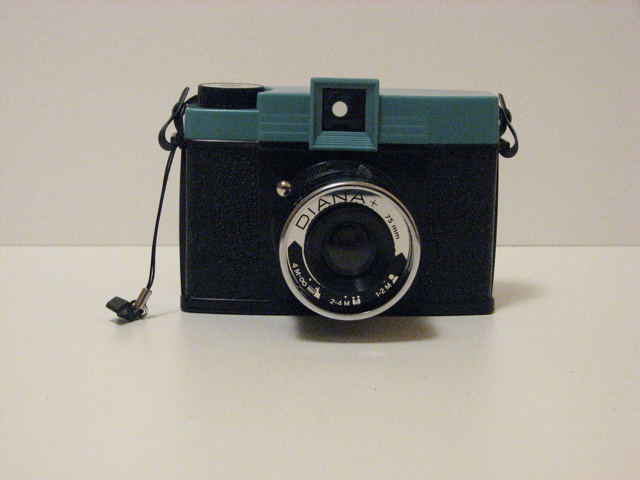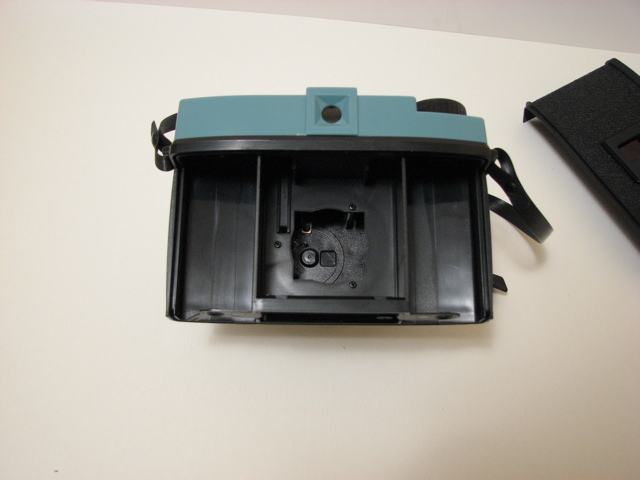Saturday
Dec082007
Review: The Diana+ Camera (Diana Plus) - Part 1
 Saturday, December 8, 2007 at 8:02PM
Saturday, December 8, 2007 at 8:02PM 
The Lomography Diana+ camera (Diana Plus) is a faithful re-creation of the ever so popular, iconic toy camera of the 1960's, the Diana camera. It offers all the same capabilities of the original, plus a pinhole, which is utilized by removing the front part of the lens barrel. The camera is also loaded with other niceties the original lacked, such as a tripod socket, standard full frame negs and special insert masks to get the traditional 16 4.2x4.2cm negs, or panoramas. They also include a little plastic piece which is used to hold the shutter open for long exposures. The Diana+ camera looks much like it predecessor, with the same look and finish.
What you get in the box

- The Diana+ camera
- 1 insert for (16) 4.2cm x 4.2cm images
- 1 insert for endless panorama (4.6cm x 4.6cm) - 16 frames with no gap between
- Diana+ book: True Tales and Short Stories. A hard-bound book of Diana images, stories, and photographs of the amazing Detrich Collection of original Diana cameras.
- Instruction manual, in English, German, Italian, French, Spanish, Chinese, Japanese, and Korean
The Camera Tour
The camera looks and feels like and original Diana. They have paid very close attention to detail when creating this camera. The materials used feel like the original. The Diana+ camera has the same lightweight feel as the Diana original.

On the front of the camera, we have the range focus setting. What's new is that the distances are set in meters, as well as the Holga-like icons. You can see the time exposure stop attached to the camera strap lug. The little attachment is a nice touch, making sure it's handy when you need it, and not at home in some drawer. Speaking of the camera strap, it is still thin plastic strip attached by little plastic knobs. Additional information on the plate states that the lens is 75mm.

From the top we see the familar Diana nameplate with the Diana+ name, and the winder knob which declares the camera uses 120 film. On the top of the lens barrel is the shutter adjustment. Like the original, you have 2 choices, B or N. The B-stop will hold the shutter open for as long as you hold the shutter down. For really long exposures, you would insert the little plastic stop into the shutter lever slot to hold the shutter open. Also there is the shutter lever. The shutter release on the Diana+ feels a little softer than an original Diana. So far, I am finding the film a little difficult to wind, especially as you progress into the roll. I guess part of the trade-off to keeping the roll tight is a slightly difficult wind knob.

On the bottom of the camera, we see the camera back lock lever, and new to the Diana+, a tripod socket. We can also see the discreet placement of the Lomography logo, which I personally appreciate. On the lens barrel, is the aperture adjustment lever. We see the 3 familiar settings, cloudy, semi-cloudy, sunny and an new addtion, P. The P is the setting for the Pinhole. On the aperture plate, they have added a pinhole, which you use with the lens removed.

On the left side of the camera, we see the alignment dots on the lens barrel. Twisting the lens to the second dot allows the removal of the lens, so that the pinhole may be used.

There's not much going on the right side of the camera. You can get a better look at the plastic B-stop insert.

On the back of the camera, we see another new addition, a Holga-like slide for the film counter window. There are 2 settings, for 12 and 16 exposures. The slide for the window moves very easily.

The inside of the camera reveals the shutter mechanism, and the plastic spool holders on the bottom of the camera. Unlike the original Diana, Lomography has engineered their camera to tighter specs, so that loose spool syndrome does not appear to be a problem. There also seems to be no need for the ubiquitous tape all original Diana users have become familiar with as part of their process. I have run 2 rolls of film through the camera and I have seen no light leakage.
That's it for the tour of the camera itself. In part 2 of my review, we'll the most important feature of the camera, how well it makes images.
in  Article,
Article,  Diana camera,
Diana camera,  Film,
Film,  Photo
Photo
 Article,
Article,  Diana camera,
Diana camera,  Film,
Film,  Photo
Photo 

Reader Comments